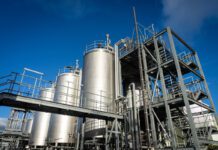
A multi-institutional team led by Colorado State University (CSU) has been awarded $5.1 million from the US Department of Energy to try to improve the profitability and efficiency of anaerobic digestion.
Anaerobic digestion refers to a cluster of natural processes by which microorganisms consume carbon-rich organic materials and produce methane and carbon dioxide in an oxygen-free environment.
Over the next five years, the CSU team led by Ken Reardon, professor in the Department of Chemical and Biological Engineering (pictured), aims to make technologically sound, economically sensible improvements to anaerobic digestion of organic waste materials in newly designed bioreactors.
“Broadly speaking, we want to improve the economic and environmental sustainability of waste treatment by producing a more valuable product and releasing less carbon dioxide,” said Reardon.
The team plans to redesign digesters by adding renewable electrons from solar or wind to the process. The electrons would redirect how microorganisms break down large organic molecules in things like grass and manure. The team will develop methods for electrons to activate carbon dioxide, produced in anaerobic digestion, and to convert the waste into two smaller carbon-chained products: hexanoic acid, which can be upgraded to a fuel and blended with gasoline or diesel; and isobutanol, which can be blended with gasoline or upgraded to jet fuel.
By directing anaerobic industrial microbiomes and engineered bacteria to make hexanoic acid and isobutanol, while limiting production of low-value methane and waste carbon dioxide, the research could seed a market for anaerobic digestion as a means of converting organic waste into higher value products.
Over the next five years, the researchers will integrate their various forms of expertise to making anaerobic digestion profitable: from altering the microbial communities, to designing the bioreactors and performing life-cycle assessments to ensure the technology would be scalable and profitable. Lab reactor experiments will eventually move to a test facility at South Dakota School of Mines and Technology, so that the researchers can run experiments more closely resembling a commercial setting.
The grant funds an educational component unusual for DOE research awards. The research will heavily involve graduate and undergraduate students, who will have opportunities to work at test facilities and take on leadership roles in the research. The scientists will also partner with CSU’s National Western Center to design an interactive, public-facing showcase of their work. Finally, the project will convene an industrial advisory board, including Leprino Foods, that integrates the perspective of for-profit companies, which may also provide internships opportunities for the students.
Quinn, along with CSU collaborators Steve Simske and Tom Bradley, also received $1 million in the same round of funding for a project on optimization of energy production pathways.






